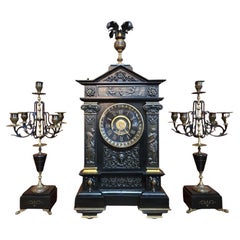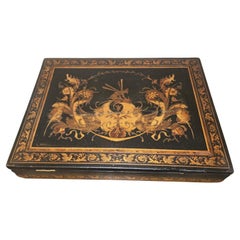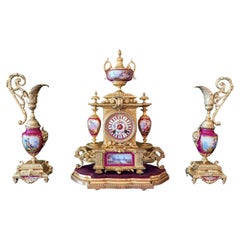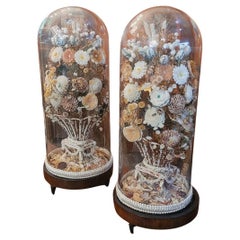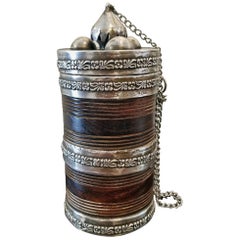Rockwell Antiques Decorative Objects
Antique Mid-19th Century French Neoclassical Revival Mantel Clocks
Slate, Brass, Bronze
Antique Mid-19th Century English High Victorian Decorative Boxes
Boxwood, Maple, Walnut
Antique 19th Century French Rococo Revival Mantel Clocks
Ormolu
Antique Early 19th Century English Regency Natural Specimens
Shell, Glass, Mahogany
Antique Late 19th Century Indian Anglo Raj Tea Caddies
Sterling Silver
Antique Late 19th Century Philippine Islamic Tea Caddies
Silver, Brass, Copper
Antique Late 18th Century French Louis XVI Bottles
Tourmaline, Gold
Mid-20th Century Italian Mid-Century Modern Vases
Art Glass
Antique Late 19th Century French Louis XVI Jewelry Boxes
Ormolu
Mid-20th Century Macanese Art Nouveau Porcelain
Porcelain
Antique 19th Century Sri Lankan Anglo-Indian Jewelry Boxes
Bone, Hardwood, Ebony, Sandalwood
20th Century Persian Islamic Desk Sets
Brass
Early 20th Century French Art Deco Picture Frames
Brass, Enamel, Ormolu
20th Century English Neoclassical Revival Decorative Boxes
Ceramic
Mid-20th Century English Neoclassical Revival Jewelry Boxes
Ceramic
Mid-20th Century American Mid-Century Modern Vases
Crystal
20th Century American Mid-Century Modern Vases
Crystal
20th Century French Art Deco Vases
Art Glass
Antique 19th Century English Victorian Desk Sets
Brass
Early 20th Century Indonesian Folk Art Figurative Sculptures
Hardwood
Antique 19th Century Indian Anglo-Indian Decorative Boxes
Bone, Shell, Sandalwood
Antique Late 19th Century Indian Anglo-Indian Decorative Boxes
Bone, Sandalwood, Teak
Antique Late 19th Century Indian Anglo-Indian Jewelry Boxes
Silver, Pewter
Antique Early 19th Century French Grand Tour Jewelry Boxes
Gold, Enamel
Antique Late 19th Century Indian Anglo-Indian Jewelry Boxes
Silver
Antique Mid-19th Century English High Victorian Sterling Silver
Sterling Silver
Antique Late 19th Century French Napoleon III Figurative Sculptures
Belgian Black Marble, Bronze
Late 20th Century Spanish Mid-Century Modern Ceramics
Porcelain
Late 20th Century Spanish Mid-Century Modern Ceramics
Porcelain
Antique Late 19th Century English High Victorian Decorative Boxes
Boxwood, Ebony, Walnut, Burl
Antique 19th Century Indian Anglo-Indian Decorative Boxes
Bone, Sandalwood, Teak
Antique Late 19th Century Indian Anglo-Indian Decorative Boxes
Bone, Sandalwood, Teak
Antique Late 19th Century Indian Anglo Raj Sterling Silver
Sterling Silver
Antique Late 18th Century Jordanian Islamic Vases
Sterling Silver, Brass, Copper
Mid-20th Century Italian Classical Roman Animal Sculptures
Alabaster
20th Century Spanish Neoclassical Revival Porcelain
Porcelain
Early 20th Century American Art Nouveau Decorative Bowls
Walnut
Early 20th Century Belgian Art Deco Animal Sculptures
Porcelain
Early 20th Century Belgian Art Deco Ceramics
Ceramic
Late 20th Century Irish Modern Crystal Serveware
Crystal
Late 20th Century Spanish Country Porcelain
Porcelain
Mid-20th Century Japanese Japonisme Sculptures and Carvings
Bronze, Iron
Antique 19th Century Irish Campaign Decorative Boxes
Crystal, Silver, Brass
20th Century American Art Deco More Clocks
Silver Plate, Chrome
Late 20th Century American Beaux Arts Animal Sculptures
Gold, Bronze
Antique Late 19th Century Sri Lankan British Colonial Decorative Boxes
Ebony, Wood
Antique Mid-19th Century Sri Lankan Anglo-Indian Decorative Boxes
Silver
Antique Early 19th Century Sri Lankan Anglo-Indian Decorative Boxes
Bone, Ebony, Sandalwood
Antique Mid-19th Century Indian Anglo-Indian Decorative Boxes
Bone, Shell
Early 20th Century Austrian Art Deco Grandfather Clocks and Longcase Clocks
Brass
20th Century American Native American Native American Objects
Agate
20th Century American Native American Figurative Sculptures
Alabaster
Late 20th Century American American Classical Busts
Granite, Bronze
Antique Late 19th Century German Victorian Wall Clocks
Brass
20th Century American Mid-Century Modern Bottles
Art Glass
20th Century American Mid-Century Modern Bottles
Art Glass
Antique Late 19th Century French Louis XV Figurative Sculptures
Marble, Bronze
Early 20th Century Belgian Art Deco Figurative Sculptures
Porcelain
Early 20th Century Japanese Japonisme Decorative Boxes
Wood
Early 20th Century Cambodian Country Figurative Sculptures
Wood
